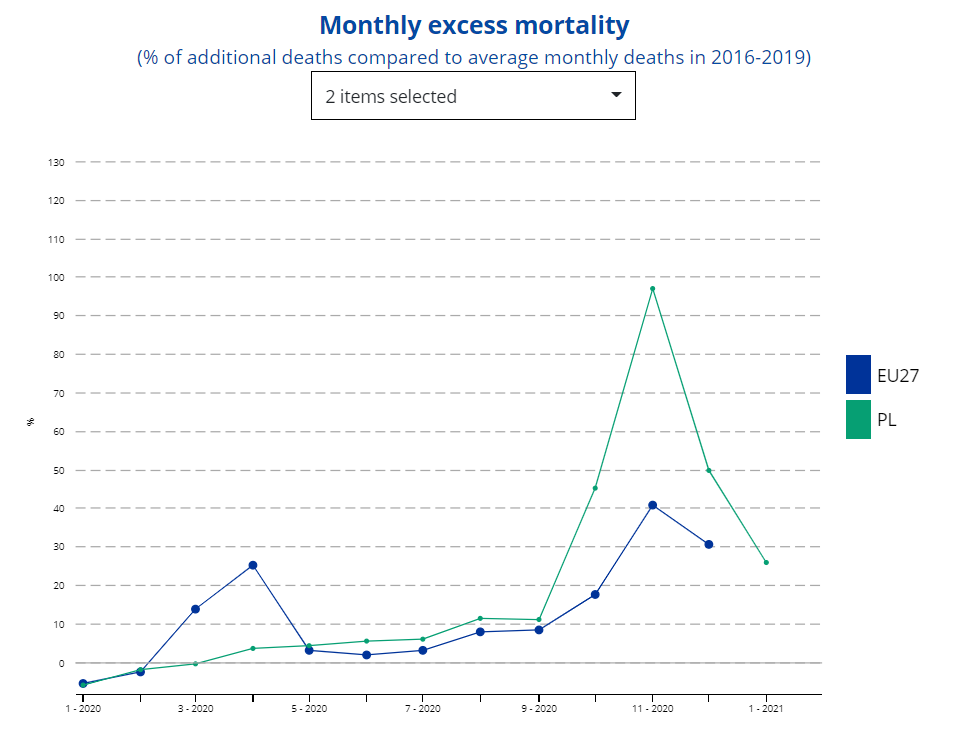Poland recorded the highest rate of excess deaths among all European Union member states in 2020. Over 20% more people died in Poland than the recent annual average.
The findings come from mortality data published by Eurostat, the EU’s official statistical service. It has released annual death figures for each member state up to 2019, and weekly death figures for 2020 (which can be added up to reach an annual total) for all member states apart from Ireland.
In Poland, 485,441 people are recorded as dying in 2020, compared to an annual average of 403,693 in the years 2016 to 2019. That is an increase in 2020 of 20.25%. Data published in January by the Polish government likewise showed around 80,000 more deaths than the recent annual average, 20% above the norm.
Source: Eurostat (annual death figures for 2016-19, weekly death figures for 2020)
According to the Eurostat data, no other country had a higher proportion of excess deaths in 2020. The closest to Poland is Spain (19.91%), followed by Italy and Slovenia (both 19.49%), and the Czech Republic (18.31%). The lowest rates were recorded in Latvia (1.82%), Finland (2.49%) and Denmark (3.08%).
Eurostat has also published figures for excess deaths in each month of 2020. These show how Poland – which introduced one of the EU’s earliest and toughest lockdowns – came through the first wave of the virus relatively unscathed, but was hard hit by the second wave in the autumn.
In November, Poland’s excess death rate reached 97%, meaning almost twice as many deaths as usual in that month. Across the whole EU, the figure was 41% in November. Poland’s rate of excess deaths in October and December was also well above the EU average.

Source: Eurostat
Among Poland’s 80,000 or so excess deaths in 2020, “only” around 28,500 were officially classified as Covid-related. That was the EU’s 13th highest Covid death rate in relation to population.
However, Poland also had the bloc’s second-lowest coronavirus testing rate and second-highest rate of tests that were positive. That suggests that many Covid-related deaths may not have been recorded in official statistics.
There are also believed to have been many deaths as an indirect result of the pandemic, as overwhelmed hospitals cut back on other services and some patients were more reluctant to seek treatment.
In its own report on this issue, Poland’s health ministry says that the 485,200 deaths recorded in 2020 was 67,000 above what was expected based on demographic forecasts. That is different from Eurostat’s methodology of calculating excess deaths by comparing 2020 mortality with the average in 2016-19.
Of the excess deaths reported by the health ministry, 43% had COVID-19 officially recorded as a cause while a further 27% were people who had previously been diagnosed with the virus. Around 45% were of people aged over 80 years and a further 49% were aged 61 to 80.
The third wave of the virus began last month in Poland, with the number of daily new cases recently passing 20,000 for the first time since November and the number of people hospitalised with COVID-19 nearing the peak reached during the second wave. The number of deaths has also been rising.
In response, Poland’s National Health Fund (NFZ), which finances the public healthcare system, has recommended that hospitals suspend planned procedures to ensure there is enough capacity for COVID-19 patients.
This week, the health ministry changed its rules on testing, allowing those who suspect they could be infected to obtain a test via an online questionnaire without requiring a consultation with a doctor.
Main image credit: Grzegorz Celejewski / Agencja Gazeta

Daniel Tilles is editor-in-chief of Notes from Poland. He has written on Polish affairs for a wide range of publications, including Foreign Policy, POLITICO Europe, EUobserver and Dziennik Gazeta Prawna.




















